Origins of Imagination
One particular Imagineer is often cited as the mastermind behind Journey into Imagination: Disney Legend (and fan-favorite) Tony Baxter. In fact, Journey into Imagination is just one of a dozen headlining projects typically credited to his portfolio (alongside 20,000 Leagues, Star Tours, Big Thunder Mountain, and Indiana Jones Adventure).
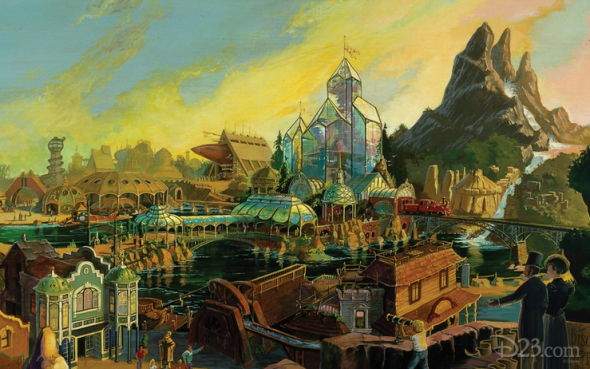
Of course, one of Tony Baxter’s most legendary projects is one that never got built. Had Baxter’s vision come to life, Big Thunder Mountain would’ve been only a piece of a larger expansion at Disneyland, culminating in an entirely new land. Plans called for this new land to expand Frontierland’s story by showing guests exactly what happened to those miners who’d struck it rich in Big Thunder’s gold deposits by continuing West to a retro-futuristic, steampunk-stylized San Franscisco…
Discovery Bay would’ve been a living, literary port of inventors, eccentrics, authors, and immigrants who’d constructed a seaside Victorian city of zephyrs, submarines, lighthouses, prismatic glass greenhouse towers, and other oddities. We took an in-depth look at the would-be history of this never-built land in its own Possibilityland: Discovery Bay feature – a true must-read for Disney Parks fans.
Of particular importance to us is one of the more clever, original experiences envisioned for Discovery Bay: an Audio-Animatronic show called Professor Marvel’s Gallery of Illusion. A young Imagineer named Steve Kirk was assigned to work on the Gallery attraction, giving initial shape to the title character… and a pet dragon he carried.
The Land – Take 1
Now of course, Discovery Bay was never built. (The space at Disneyland it was set to inhabit stayed empty for decades, though, before eventually becoming Star Wars: Galaxy’s Edge.) But it’s often said that good ideas never die at Disney, and that’s especially true here. Steve Kirk recalled to WDW Radio that by 1976, designers across WED Enterprises had been pulled away from other projects to focus on the looming opening of EPCOT Center. Each lead Imagineer was assigned a corporation with whom they could co-develop a pavilion.
Though Disney had a sense for the topics they intended to cover, the design and contents of each pavilion would be shaped in part by the whims of the sponsoring organization. In the late ’70s, a logging company had signed on as sponsors of The Land pavilion, with Tony Baxter assigned as the project lead. Together, they envisioned a spectacular pavilion celebrating the Earth’s ecosystems. (Never mind the seeming contradiction of a logging company aligning its brand with a celebration of forests… an inherent flaw in the sponsorship model, to be sure.)
Mock-ups and models of Baxter’s version are astounding (and not surprisingly, mirror impressive elements of the cancelled Discovery Bay): he imagined the pavilion taking the form of a glass mountain made up of seven crystalline prismatic towers, each housing one of five different habitats plus an agricultural and urban section. The Land’s thesis, in a sense, was to cast us as protectors of nature by understanding its beauty and complexity. The pavilion would’ve included a rotating restaurant that gave the impression of being high in the branches of a tree.
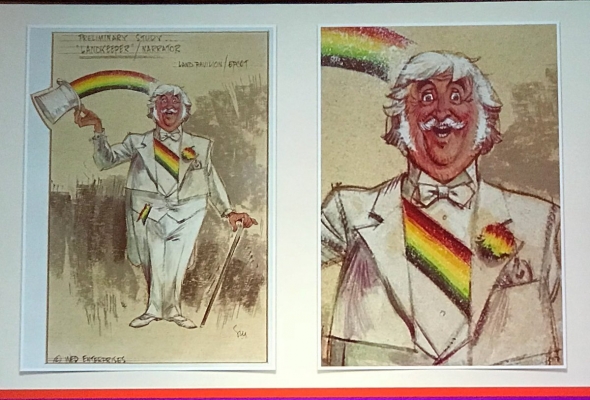
In fact, Baxter’s initial idea for The Land even adapted the Professor Marvel character initially designed for Discovery Bay. Working off the concept, Tony and his team even developed a central figure whose presence and narration could be felt throughout each attraction within: the Landkeeper.
The headlining attraction, narrated by the Landkeeper, would’ve been a suspended dark ride with guests seated in hot air balloons passing through spectacularly scaled dark ride scenes. The ride would’ve begun on a mountaintop during the winter, following the melting snow down through various ecosystems and the four seasons. In the big finale, the balloons would’ve soared out of the auxilliary dark ride showbuilding and into the crystal towers, floating through the canopies of the real habitats guests were walking through below.
So why wasn’t this wondrous vision of The Land pavilion brought to life? Simple – sponsorship.
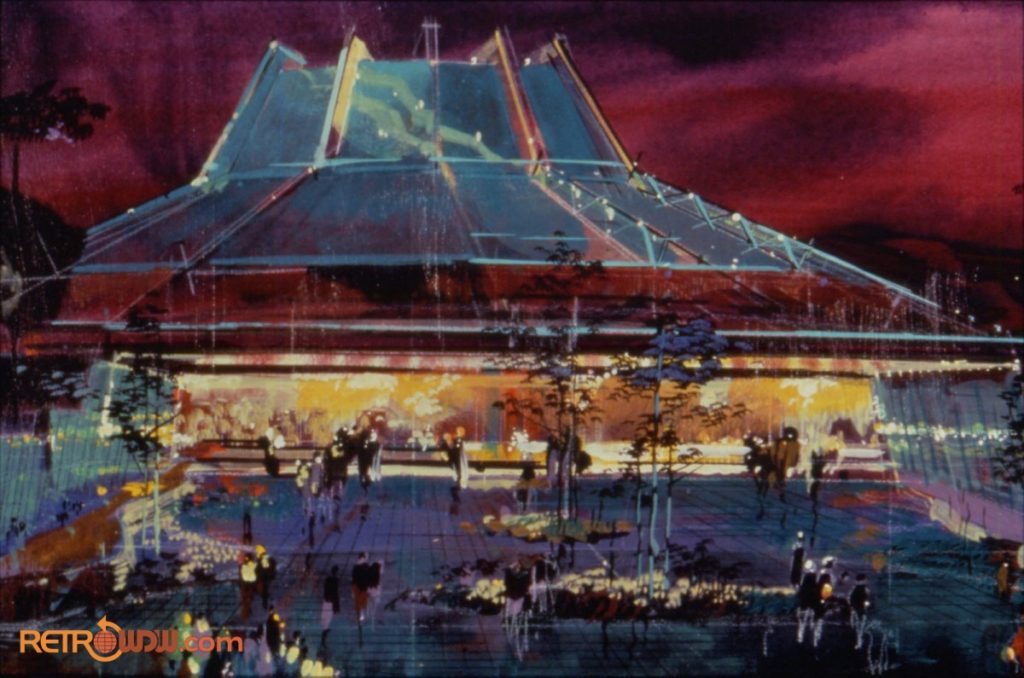
In 1978 – well into EPCOT Center’s concepting – the logging company that had originally signed on to sponsor The Land dropped out, and Kraft Foods stepped in to take over financing. While Baxter’s ideas might’ve been stunning, Kraft’s expertise and messaging wasn’t in ecosystems. Rather than focusing on habitats and environmental protection, Kraft wanted their version of The Land pavilion to focus on agriculture and farming – a much more fitting message for that company. Hence, The Land’s final three attractions (Listen to the Land, Symbiosis, and the Lost Legend: Kitchen Kabaret) focused heavily on agriculture, nutrition, and harvesting.
But don’t worry. Tony Baxter was not out of a job.
Reimagining

Instead, Baxter and his team began considering new ideas for attractions that would fit within Future World’s industrious and educational line-up… A-ha! Given that drafts for Discovery Bay had become sketches for the Land which would now inspire another idea, and that the kindly, inventive, professor character had been carried through each, it’s appropriate that the team began to consider an EPCOT-style attraction based on something a little more abstract than oceans or agriculture or transportation: where ideas come from.
And according to Kirk, “I think Tony had the idea that new ideas are the product of collecting old ideas and then synthesizing them into a third new product… That was kind of the basic premise of the storyline. So the idea of some kind of a metaphor for gathering creative ideas or even natural things or other concepts that had been existing before, recombining them, was the angle.”
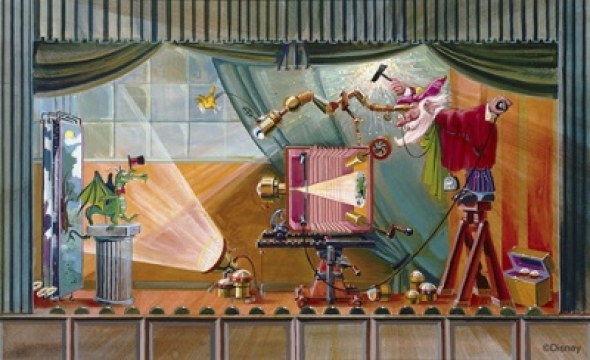
Kirk tidied up old sketches of Professor Marvel and his dragon, resulting in the a white-bearded, monocled Dreamfinder and his little green dragon, Figment; characters that just might come in handy for another of Future World’s pavilions, should a sponsor be interested. And wouldn’t you know it? One was.
The empty plot of land next to the under-construction Land pavilion was earmarked for another pavilion. The topic hadn’t been decided yet, but the sponsor had. Long-time Disney partner Kodak had been a resort-wide sponsor in photography for years. Kodak sponsored the dozens of film shops around the property (stocked with Kodak film, disposable cameras, and photo processing services), Kodak Photo Spots arranged at key vantage points around the resort, and even the complimentary park guide maps positioned at each park’s entrance.

As part of their larger partnership, Kodak would sponsor whatever pavilion ended up on the expansion pad south of The Land. Their only request was that whatever Disney Imagineers designated as the pavilion’s theme, the contents of the pavilion be something “very imaginative.”
The proposal seemed like the perfect application of the Dreamfinder and Figment designs. Tony said, “The story needed to describe the complex process in an engaging, interactive way without seeming like a lecture. A persona was needed to give the process personality, but having a human character seemed too selective. A friendly imaginary being that could delight in the wonders of imagination would be more inclusive.” In other words, guests needed a whimsical, carefree dreamer to bring the idea of imagination to life.
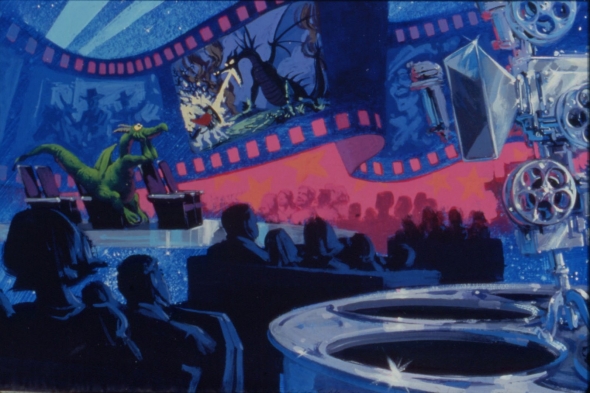
Again according to Kirk’s recollection, “Tony was in with the Kodak folks as being potential sponsors for some kind of pavilion, and I don’t think he quite knew yet what their tie-in would be. And he ran into my office in the middle of this meeting and said ‘Can I borrow little Figment and Dreamfinder?’ or Figment and . . . yeah, Dreamfinder at the time. And he grabbed it and took it in to them to show it to them, and he said this is the kind of character development we can do as being a host for a pavilion; maybe on Imagination. And they said ‘That’s great. Do we get the dragon, too?’ And Tony said, ‘Oh, yeah, yeah, yeah, yeah.'”
Their only edit? They offered that the green dragon was reminiscent of the logo of their biggest competitor, Fujifilm. Initial character models established by Steve Kirk (above) were further fleshed out by Andy Gaskill and X Atencio (lyricist behind “Yo Ho (A Pirate’s Life for Me)”) to make the dragon “lovable, in a way that kids could relate to.”
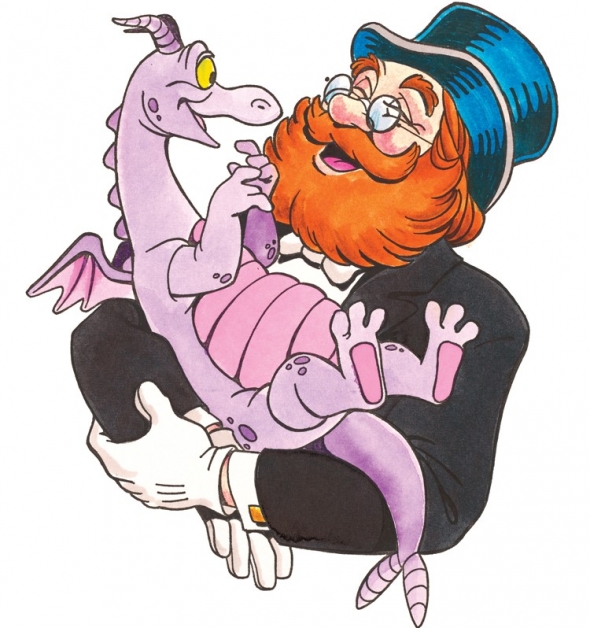
Voila! Figment became a childlike purple dragon with goat horns, innocent naïveté, and endless musical enthusiasm for dreaming. United at last, Imagineers got to work on a story. By the way, the imaginative duo rank high up on many lists of the Greatest Characters Created Just for Disney Parks.
Together, Dreamfinder and Figment would take guests on a journey through the imaginary landscapes of Art, Literature, Performing Arts, and Science – all invaluable catalysts to imagination. Are you ready to Journey Into Imagination? On the next page, we’ll walk you through the ride from beginning to end! Let the journey into imagination begin!





